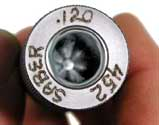While the Saber-Tooth Punch makes teeth in the lead extending from a seated core, or in an all-lead bullet, the fragile teeth on the punch will be broken if they are allowed to press more than just lightly into the jacket edge. To make a jacketed open tip bullet with saber tooth "folds" in the end of the jacket, you can use this special version of the point forming die, and then refine and reshape the ogive using a conventional point forming die as the final step.

Rather than seating the lead core so it is longer than the jacket, you will want to use a core that seats shorter than the jacket. This requires a punch which fits inside the jacket, rather than a punch that fits the core seat die ID. Since different jacket types and brands may have different wall thickness, the ID can be significantly different, and thus the punch will need to be made for a given jacket. (If it happens to fit other jackets, this is a bonus...and often, it will.) Some jackets are made with a tapered wall, thin toward the mouth and thicker toward the base.
If your jacket is made this way, you will need to determine an approximate weight (set by the length of the core) at which a given core seating punch will fit well and seal the ID at that particular point. If you then try to make a much longer jacket, the same punch will allow lead to leak or bleed around it, since the jacket ID will be larger toward the jacket mouth. This is why you may need additional punches, even for the same jacket, if you make significantly heavier bullets than the original design. (Over a narrow range, the fit will be close enough to work). Making a lighter bullet means that your core will be shorter, and the punch that fit perfectly with a heavier bullet will be too large to drop down into the smaller, tapered ID of the jacket. The punch will "dig" into the jacket wall, which can result in wrinkles in the shank or undersized bullets. Again, with tapered wall jackets, you may need two or three different size core seating punches for open tip bullets if you wish to make a wide range of weights.
Making a lighter bullet means that your core will be shorter, and the punch that fit perfectly with a heavier bullet will be too large to drop down into the smaller, tapered ID of the jacket. The punch will "dig" into the jacket wall, which can result in wrinkles in the shank or undersized bullets. Again, with tapered wall jackets, you may need two or three different size core seating punches for open tip bullets if you wish to make a wide range of weights.
Once you have the core seated (below the jacket mouth), then insert the seated core/jacket combo into the special saber tooth point forming die. This die is made with a fluted or ridged ogive cavity and a fairly large ejection pin, so that the edge of the jacket is rounded over and folded into the toothed configuration without encountering a thin, sharp punch edge.
The ogive shape resulting from this operation is more blunt than you may desire, and it isn't practical to try to increase the sharpness of the die curve and still get good deep folds in the jacket, so you will want to use a conventional point forming die as a final step. This provides a more refined and professional appearance to the bullet than would be possible by using the saber tooth forming die by itself.
Saber tooth forming dies are available as the PF-ST-S, and PF-ST-H only (not made in -R or -M). All calibers are available from .14 to 1-inch Gatling. The most popular calibers are medium and large bore handgun, such as 9mm, 40, 41, 44, and 45, but the saber tooth style can be used in rifle calibers as well. You can simply add the PF-ST-S (type -S for the S-Press CSP-1) or the PF-ST-H (type -H for the Mega-Mite CSP-2, Hydro Junior CSP-2H, or HydroPress CHP-1) to any 3-die set. It can also be added to the 4, 5, and 6 die sets (which have capability of either lead tips, rebated boattails, or both) but the lead tip isn't appropriate. Any die set that has at least 3 dies is capable of making an open tip bullet, of course, so you can just stop short of using the lead tip die to make open tip saber tooth designs with any set.
Start writing here...
About Corbin Point forming Saber-Tooth Die